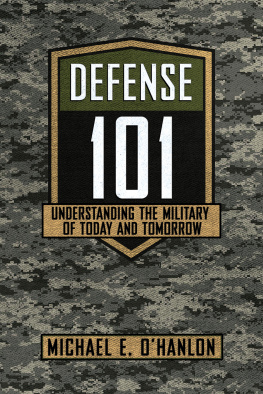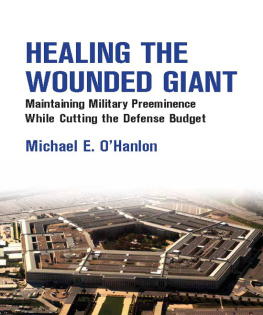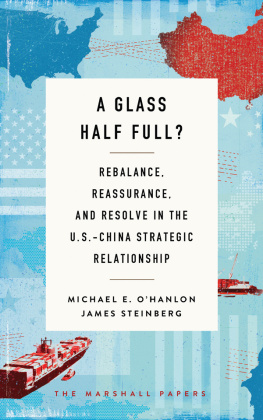DEFENSE 101
Understanding the Military of Today and Tomorrow
Michael E. OHanlon
CORNELL UNIVERSITY PRESSITHACA AND LONDON
To my research assistants over the years at Brookings, including Stacey, Christina, Julien, Sue, Micah, Aaron, Adriana, Nina, Jason, Ian, and Adam, and in memory of Bruce Blair, Janne Nolan, and John Steinbruner
INTRODUCTION
A Primer on the US Military Machine
Modern warfare is a remarkably technical and complex human endeavor. The organizations that carry it out are among the largest institutions on earth. Some of the most sophisticated inventions ever fielded undergird the vehicles, weapons, sensors, communications systems, and other key hardware with which wars are fought. Large fractions of government budgets around the world provide the resources to build military institutions in peacetime and to conduct combat operations during times of war.
The main focus of this book, the American military, is simply a behemoth. Nearly 3 million people work directly for the US Department of Defense (DoD), in uniform or as civilian government employees, across the country and around the world. About 20 million more living Americans have served in uniform in the nations armed forces in the past. The US military wields some 5,000 nuclear weapons, though they are built and maintained by the National Nuclear Security Administration within the Department of Energy. The Department of Defense and Department of Energy together run research laboratory systems that continue to invent some of the worlds most cutting-edge technologies. Together their annual budgets for research, development, testing, and evaluation of new technologies easily exceed $100 billion; the total budget for US national defense is roughly three-quarters of a trillion dollars a year. The Department of Defense includes four major military services, each with its own distinct culture, rank system, and command structure. It now also includes a niche space force as a fifth military service; the US Coast Guard, although administered within the Department of Homeland Security in peacetime, is a sixth.
How to make sense of all of this, without worrying about every insignia, every regimental flag, every small base operated by the American armed forces, or each and every dollar spent defending the nation? How to understand the basics of warand the most important characteristics of the military that are relevant to core matters of US national security? These are the central questions that motivate this book.
The book is designed less to address immediate policy issues than to provide some of the basic knowledge and analytical tools that will be relevant regardless of which security problems become most acute in the years ahead. We know that matters of war and peace will always be important in the modern world, as they have been throughout history. We can also be sure that military budgets will be large for most countries for years to come, and therefore that methodologies for making them as efficient as possible will be central to good public policymaking. Thus, this book is intended first and foremost as a primer and textbook in a field of enduring importance, not as a policy tome to address a particular problem of the day.
That said, I should also speak to several contemporary security debates of major importance for the nation and the world. One crucial matter is that, if history is a guide, policymakers may again forget the risks and likely costs of war. Doing so is usually incorrect, and always dangerous. It is too easy, during times of rapid technological and strategic change like today, for leaders to persuade themselves that new weapons and new concepts of warfare will greatly improve the prospects for rapid victory by a technologically superior country. Such hubris could affect the decision making of the United States, and perhaps other countries, in unfortunate ways in the years to come.
A second major debate that the information and methods presented here can help illuminate concerns Americas proper global security role. This debate is happening at a time when projected trillion-dollar annual federal deficits, now further increased by COVID-19, stretch as far out as the eye can seeconstituting an insidious threat to US economic prosperity and thus national security themselves. In this context, policymakers need better tools to understand the implications of various possible visions of US grand strategy for the size and shape of the US defense budget. Grand strategy is a somewhat arcane and grandiose term that inevitably requires adjustment when theory meets real-world crises and circumstances. Even so, it is important to have a general concept of how a country seeks to protect its security as well as its broader interests when designing a defense program and budget. Third, while hawks and doves are important in todays US debate, challenging each others core assumptions and logic, there are some dangerous strands of thinking on both the left and the right. ber-hawks believe that American military preeminence of the type enjoyed in, say, the 1990s is again attainable if we only put our minds to it and spend enough; given technological realities and trends, as well as Chinas rise, I do not think that is a realistic position. And some doves believe that American defense budgets and technologies are so predominant that the United States can afford big and even somewhat indiscriminate cuts in military spending. Such thinking ignores the fact that adversaries can often challenge the United States asymmetrically, especially on or near their own territories, even when spending far less on their armed forces. I challenge such misconceptionsor at least discuss the kinds of tools that can help others to do so.
There is, unquestionably, an art of waras Sun Tzu wrote millennia ago, and as many other great scholars and historians over the years have underscored. There is also a politics of war, where human passions intersect with the interests, institutions, and group or national identities of key peoples and their leadersas great writers from Thucydides to Machiavelli to Clausewitz have dramatized over the centuries. The politics of war includes the hugely important subject of civil-military relations, as well as matters of bureaucratic and organizational performance. And, of course, there are troves of important studies on military history, which also demand attention from anyone who is serious about the military profession and national security policymaking today.
This book, building in part on a text I wrote a decade ago, is, however, not about the art, politics, or history of war, but instead the science of war. By that expression, I mean a subdiscipline of defense analysis that, beginning with a foundation of basic facts and figures about military organizations and operations, uses analytical methods to tackle key questions in the national security field. Those methods include simple computational algorithms for assessing military effectiveness and predicting combat outcomes. They include study of defense budgets and economics, as well as efforts to understand the physics and technology of military weapons and operations today.









